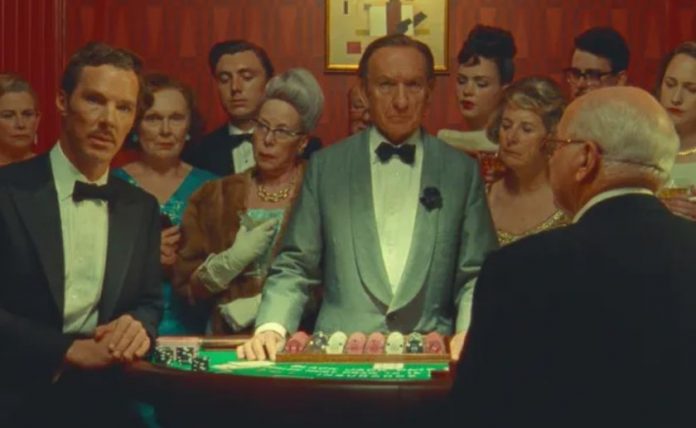In 2023, acclaimed filmmaker Wes Anderson released his riveting cinematic invention “Poison,” which told the gripping story of a mysterious poison that slowly kills its victims. This intriguing short film (18 minutes), which you can see on the massive streaming service Netflix, is set against the backdrop of British-ruled India and weaves a tale of mystery, friendship, and the complexity of human nature.
Dev Patel‘s character, Timber Woods, in Wes Anderson’s “Poison” (2023), which is set against the backdrop of British-ruled India, rushes to his friend Harry Pope’s residence only to discover him immobilized by a poisonous snake, a krait, on his stomach. To assist in getting rid of the snake, Timber phones Ben Kingsley‘s character, Dr. Ganderbai. The three throw themselves into a furious struggle, using chloroform and antivenom. The unexpected turn of events, though, occurs when it is discovered that Harry’s stomach is not inhabited by a snake despite all the attempts. This revelation throws doubt on the nature of reality, heightens the tension in the story, and provides a window into the volatile dynamics of British-ruled India. As we delve into the complexities of this cinematic masterpiece, tvacute will examine its plot consider whether it is based on a true story, and make parallels with its famous author Roald Dahl’s book.
Is the 2023 Netflix film “Poison” based on a true story?
No, “Poison”(2023) is based on a true story. Inspired by Roald Dahl’s 1950 short novel “Poison,” the movie takes its cues from the same name. Dahl’s story served as an inspiration for 2023 adaption filmmaker Wes Anderson, who reworked it for the big screen. The story’s essential components are still present, but Anderson added his own directorial flair and made some significant adjustments—most notably in the climax—to produce a cinematic experience that appeals to a contemporary audience.
The choice to place the plot in India during the British Empire lends a rich historical and cultural context to the story. By straying from reality, Anderson is able to investigate topics such as perception, race dynamics, and how historical context affects human relationships without being constrained by the requirements of a factual narrative.
“Poison” is essentially a monument to the ability of storytelling to engross people in fully immersive experiences. Even though the movie isn’t based on actual events, its makers’ skill is evident in how they were able to stir up feelings, encourage reflection, and tell a compelling story.
What Sets Poison Apart From Roald Dahl’s Story?
The version of Roald Dahl’s “Poison” directed by Wes Anderson demonstrates the mutually beneficial link between literature and film. While the movie remains faithful to the main plot of Dahl’s book, there is a noticeable divergence in the latter scenes that adds layers of modern relevance and complex character dynamics.
In Dahl’s original story, Timber and Dr. Ganderbai leave Harry’s house following the snake-related incident. Timber apologizes to Ganderbai for Harry’s behavior, and Ganderbai, in a condescending way, says that Harry was under the effect of chloroform and that a lengthy vacation would be the best course of action. Nevertheless, Anderson makes a major change to this resolution.
In Anderson’s version, Timber apologizes to Ganderbai for Harry’s actions and tries to persuade him that he saved Harry’s life. But Ganderbai answers coldly, saying Timber isn’t capable of being sorry. The film “Poison” ends with a slight but significant change that presents a contemporary viewpoint on racial dynamics and how to deal with discriminatory conduct.
The choice to change the conclusion complies with modern sensibilities by depicting Ganderbai’s behavior as a justifiable response to acts of racism. In contrast to Dahl’s story’s 1950s context, where such behavior would have been accepted, Anderson’s adaptation makes characters answerable for their deeds. Ganderbai’s rejection of excuses raises questions about our shared obligation to confront and dismantle discriminatory beliefs, even when they exist in the friendship setting.
Essentially, the final scene of “Poison” has been changed to reflect changing social conventions while also bringing the story up to date for a contemporary audience. The characters’ interactions, especially how racism is confronted, take center stage in Anderson’s version, which makes it a timely and moving examination of interpersonal connections in a historical setting.
In the mosaic of brilliant filmmaking, “Poison” (2023) sticks out as a skillfully constructed work that skillfully combines elements of psychology, societal commentary, and mystery. With the help of the cast’s outstanding performances and Wes Anderson’s directing skills, a story that transcends time and space is brought to life.
Viewers are taken through periods of acutte panic brought on by the snake, and the discovery of the missing serpent provides a point of reflection. The video invites contemplation on the brittleness of perception and the complex dance between the actual and the imagined. In addition to its compelling story, “Poison” explores the underlying tensions by acting as a mirror reflecting the social dynamics of British-ruled India.
Although the film is influenced by Roald Dahl’s original novel, it also explores new ground by presenting complex character dynamics and a modern take on racial dynamics. The choice to depart from Dahl’s conclusion adds layers of significance, turning “Poison” into a reworking that appeals to a contemporary audience rather than just an adaptation.
The film “Poison” (2023) stands as a testament to the transformational power of narrative within the larger tapestry of cinematic storytelling. In addition to watching the drama play out on TV, it encourages viewers to reflect, question their own beliefs, and go against social norms. “Poison” by Wes Anderson is not just a movie; it’s an immersive experience that creates a lasting impression on the storytelling landscape.
Netflix’s Poison (2023) Movie: Explained!




